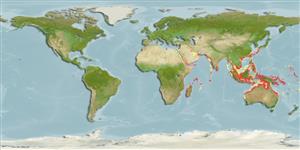Common names from other countries
Teleostei (teleosts) >
Pleuronectiformes (Flatfishes) >
Soleidae (Soles)
Etymology: Zebrias: Derived from Zebra = African horse, referring to the stripes (Ref. 45335).
More on author: Kaup.
Environment: milieu / climate zone / depth range / distribution range
Ecology
Marine; demersal; amphidromous (Ref. 51243). Tropical
Indo-West Pacific: Red Sea and Persian Gulf to Malaysia and Thailand, north to China, south to Australia.
Size / Weight / Age
Maturity: Lm ? range ? - ? cm
Max length : 15.0 cm TL male/unsexed; (Ref. 30573); common length : 12.0 cm TL male/unsexed; (Ref. 30573)
Inhabits shallow coastal waters, on sand and mud bottoms (Ref. 30573). Feeds mainly on benthic invertebrates. Sold fresh in markets.
Life cycle and mating behavior
Maturities | Reproduction | Spawnings | Egg(s) | Fecundities | Larvae
Menon, A.G.K., 1984. Soleidae. In W. Fischer and G. Bianchi (eds.) FAO species identification sheets for fishery purposes. Western Indian Ocean (Fishing Area 51). Vol. 4. FAO, Rome. pag. var. (Ref. 3505)
IUCN Red List Status (Ref. 130435)
CITES (Ref. 128078)
Not Evaluated
Threat to humans
Harmless
Human uses
Fisheries: commercial
Tools
Special reports
Download XML
Internet sources
Estimates based on models
Preferred temperature (Ref.
115969): 24.6 - 29.1, mean 28.2 (based on 1184 cells).
Phylogenetic diversity index (Ref.
82804): PD
50 = 0.5000 [Uniqueness, from 0.5 = low to 2.0 = high].
Bayesian length-weight: a=0.00933 (0.00538 - 0.01619), b=3.12 (2.97 - 3.27), in cm Total Length, based on LWR estimates for this species & (Sub)family-body (Ref.
93245).
Trophic level (Ref.
69278): 3.5 ±0.37 se; based on food items.
Resilience (Ref.
120179): High, minimum population doubling time less than 15 months (Preliminary K or Fecundity.).
Fishing Vulnerability (Ref.
59153): Low vulnerability (10 of 100).
